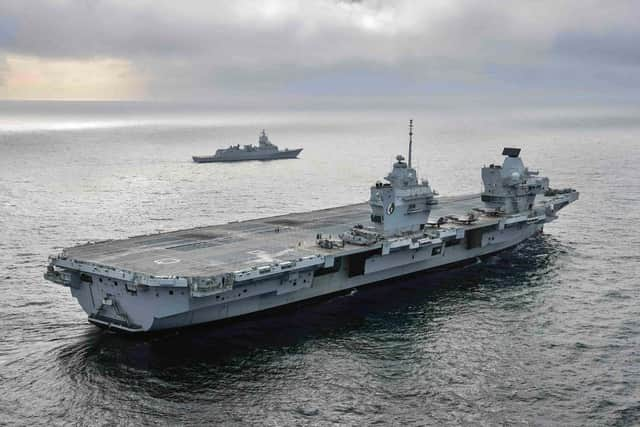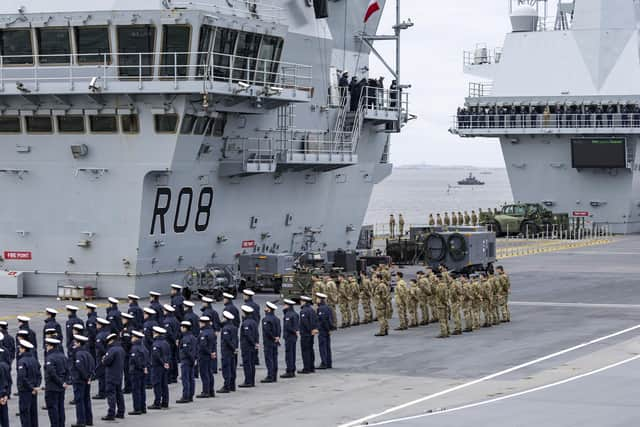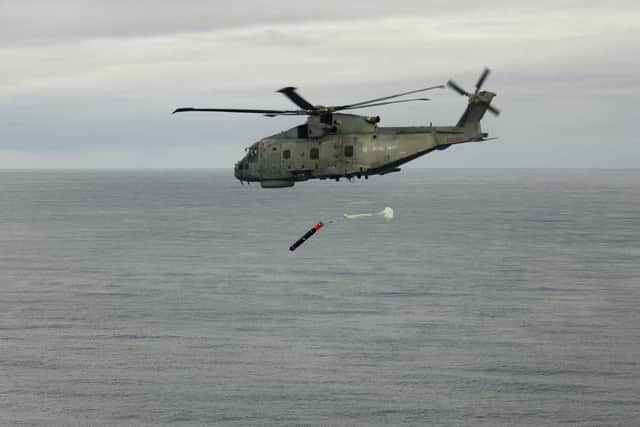Royal Navy: HMS Queen Elizabeth's aircraft launch torpedoes and test weapons during Carrier Strike Group task
and live on Freeview channel 276
HMS Queen Elizabeth is continuing her Autumn deployment as the UK Carrier Strike Group flagship. She was deployed on September 8.
The crew onboard the Portsmouth-based aircraft carrier have joined forces with their allies and the RAF to carry out ferocious strike missions – testing their capabilities to the limit.
Advertisement
Hide AdAdvertisement
Hide AdF-35 Lightning jets, Merlin and Wildcat Helicopters and several different Air Squadrons carried out the exercises alongside Norwegian and Swedish forces and their Joint Expeditionary Force (JEF) allies.


JEF is a s a high-readiness task group committed to regional security that can respond to crises alongside Nato or as an independent force.
The 65,000 tonne warship met up with the Norwegian frigate HNoMS Otto Sverdrup to practice close manoeuvres. Merlin helicopters from Culdrose-based 820 NAS and Wildcats from Yeovilton-based 847 NAS tested their capabilities in an advanced game of hide and seek.
They alongside the Norwegian stealth corvette HNoMS Steil, with the Merlins labelled the ‘guardians’ and tasked with giving situational awareness and providing the Wildcats with the location of suspect vessels. Naval exercises also involved a Norwegian Skjold patrol vessel, which used her thermal cam nets, knowledge of the fjords and anti-ambush tactics, techniques and procedures to test the capabilities of her crew.


Advertisement
Hide AdAdvertisement
Hide AdThis gave UK flight crews a realistic training scenario which prepared them for any future deployment. A Merlin helicopter then launched a Training Variant Torpedo (TVT) abeam of Type 23 frigate HMS Portland. This was a first for any HMS Queen Elizabeth aircraft.
Observers Scott Wilson and Tobias Williams dropped the TVT to test the aircraft’s external weapon processes and delivery systems. The torpedo was then collected by the warship’s sea boat and returned.
F-35 Lightning stealth fighters were also tested to their maximum capabilities, by joining in with the Norwegian-led Exercise Phoenix Strike. This saw the jets carrying out air-to-air tactical intercepts and testing themselves against mock enemy air defences.
The F-35s then carried out the live strike missions in Swedish ranges, firing Paveway IVs – air to ground precision-guided bombs – alongside the Swedish Armed Forces. Wing Commander Stew Campbell, Commanding Officer of 617 Squadron, The Dambusters, said: “617 Squadron have enjoyed an extremely successful five weeks embarked in HMS Queen Elizabeth.


Advertisement
Hide AdAdvertisement
Hide Ad“We have experienced a graduated and increasingly complex training package that has seen us qualify multiple new pilots in carrier operations both day and night, take part in both UK and foreign led large force exercises and employ live ordnance on an air to surface range.
“617 Squadron always enjoy our embarked periods as operating from an aircraft carrier is the pinnacle of aviation activity and we are proud to be a part of it.” Following the exercises, HMS Queen Elizabeth undertook a port stope in Gothenburg, Sweden.
She hosted events committed to JEF to forge deeper bonds between the nations’ armed forces. Commanding Officer Captain Will King said: “After a lengthy time at sea, my ship’s company and I were delighted to arrive in Gothenburg.
“We looked forward to hosting defence engagements events to strengthen our long-standing defence connections with Sweden and enjoying a well-earned rest to experience the city."